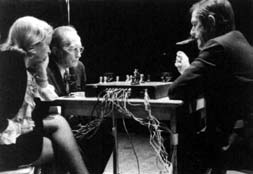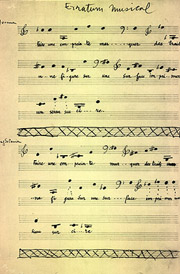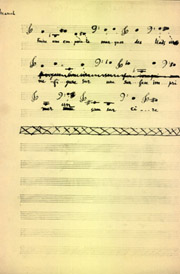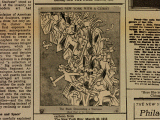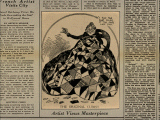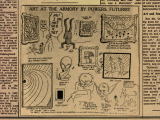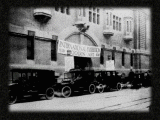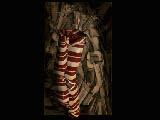click to enlarge
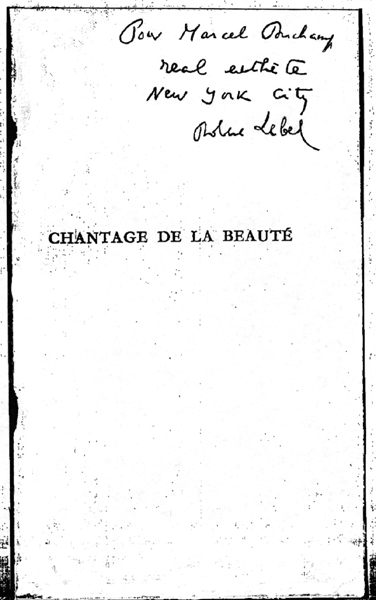
It is currently impossible to gather in its entirety, indeed to reconstitute in its integrity, Marcel Duchamp’s book collection. And maybe this will forever be the case, given that the man lived in small apartments or hotels for long periods of time, and that he moved a lot between two continents. Certainly, this precariousness did not favor the preservation of any given collection, apart from maybe one during the 20’s in his chess-playing period (after he left The Large Glass unfinished, in 1923) – but that collection is of the artwork of Picabia and Brancusi and is a different question.
Meanwhile, the thought is not forbidden that one could attempt a complete collection, or at least the most thorough list, of all printed matter that could have been, at one time or another, connected with Duchamp: he preserved things, his family, friends and female companions preserved things (there is evidence of this), and Duchamp mentions these things in his writings, interviews, etc. It is immense work, just beginning, and must be taken slowly.
Within this ensemble, it is already possible to denote a sub-ensemble: those of the exemplars which were autographed to Duchamp.(1) The “constellation” formed by these books which have been marked with a handwritten addition (and even, in certain cases, a pictorial addition) is precious in that it allows us to make up a portrait of the dedicatee through the various “titles” he is given.(2)
Not in the slightest bit exhaustive, I will only rapidly tackle a few dedications chosen from among those I know. Only one, the last, has in fact been published.(3)
***
I will egin very simply with a non-dated dedication (but seemingly from 1948, ate of this book’s publication) from an old accomplice, André reton (1896-1966).
| À Marcel DuchampCe petit papillon exotiqueQu’on invite à ne pas tropInsister à sa fenêtre à l’Ami numéro 1 |
To Marcel Duchampthis little exotic butterfly that we invite not to insist too much at his window to the number 1 Friend | |
|
– Martinique charmeuse de serpents. Paris: Ed. du Sagittaire, 1948 [printing completed on 25 August 1948]. |
||
On the occasion of his stay in North America (1941-1946), Breton, who did not speak English and lived within a circle of exiled French intellectuals (including Marcel Duchamp from 1942 on) did not hesitate to visit French-speaking areas this side of the Atlantic: Martinique (April-May 1941), the Province of Quebec (August-November 1944) and Haïti (December 1945-February 1946).(4) It was during one of these trips that Martinique charmeuse de serpents, a collection of prose and poems by André Breton and André Masson, was initiated. It was then published after Breton’s return to Paris whilst Duchamp, “number 1 Friend,” was back in the United States.
In the autumn of 1960, Duchamp said of his longtime friendship with Breton (they had known each other since the summer of 1921): Une grande sympathie avec Breton. Il y avait une sympathie comme avec Picabia. Une sympathie d’homme à homme, plutôt que de théorie à théorie [A great sympathy with Breton. There was a sympathy as with Picabia. A sympathy from man to man, rather than
from theory to theory.](5) As for the window motif, it is worth remembering hat it allows us to bring these two men together. In 1924, Breton wrote he first Surrealist Manifesto in which he reflected on the automatically ritten sentence: quelque chose comme: ‘Il y a un homme coupé en deux par la fenêtre’ [something like: ‘there is a man cut in two by the window’]. Then in 1936, Breton wrote a poem, Au lavoir noir, which was illustrated by Duchamp with the reproduction of a window, La bagarre d’Austerlitz [Brawl at Austerlitz], a readymade (1921).
***
When, in 1954, Robert Lebel (1901-1986) asked André Breton to write a preface for his new book, Chantage de la beauté, Lebel had already started working on the biography and catalog that would be Sur Marcel Duchamp, his next book.(6)
Breton wrote the preface in November 1954 and the Editions de Beaune published the book in Paris in April 1955.(7) Lebel sent it to Duchamp with this dedication: Pour Marcel Duchamp / real esthète / New York City / Robert Lebel. [For Marcel Duchamp / real aesthete / New York City / Robert Lebel.] Duchamp would later respond via letter (4 August 1955):
|
Cher Lebel Bien reçu Chantage que j’ai lu comme je lis Platon càd à grande allure – Nevertheless il m’en reste beaucoup collé à matière grise. Dear Lebel Received Chantage and have read it as I read Plato which is to say at great speed – Nevertheless there is a lot of it left stuck in my gray matter. |
In early July, after two days of shooting at the Philadelphia Museum of Art with James Johnson Sweeney, Duchamp took a few weeks rest in East Hampton, NY, at the house of one of his wife’s friends.(8)
The relationship between the artist and the spectator, analyzed with elegance and earnestness in this little book, is also a question debated by Duchamp himself, as exemplified in the following:
– in a letter to his brother-in-law Jean Crotti, 17 August 1952, published in the Jean Crotti exhibition catalogue (Galleria Museum, Paris, December 1959-January 1960):
|
Les artistes de tout temps sont comme des joueurs de Monte-Carlo et la loterie aveugle fait sortir les uns et ruine les autres. […]Je ne crois pas à la peinture en soi. Tout tableau est fait non pas par le peintre mais par ceux qui le regardent et lui accordent leurs faveurs […]. Artists of all time are like gamblers in Monte-Carlo and a blind lottery draws certain ones and ruins the others. […]I do not believe in painting in itself. A painting is not made by the painter but by those who look at it and grant it their favor […] |
– in an interview with Jean Schuster, January 1955, published in Le Surréalisme, même (Paris, no. 2, Spring 1957):
|
Ce sont les REGARDEURS qui font les tableaux. It is the ONLOOKERS who make the paintings. |
– in a letter to Jehan Mayoux, 8 March 1956, published in his book La Liberté une et divisible: Textes critiques et politiques (Ussel, Éd. Peralta, 1979).
|
[…] une oeuvre est faite entièrement par ceux qui la regardent ou la lisent et la font survivre par leurs acclamations ou même leur condamnation. […] a work is made entirely by those who look at it or read it and who make it survive by their accolades or even their condemnation. |
– in The Creative Act, a brief paper written in English in January 1957, given in Houston in April 1957, and published in Art News (New York, no. 4, Summer 1957):
|
All in all, the creative act is not performed by the artist alone; the spectator brings the work in contact with the external world by deciphering and interpreting its inner qualifications and thus adds his contribution to the creative act. |
As we can see, none of these writings or sayings were known of at the time that Lebel published his book and Lebel, on this question, was opposed and would continue to be opposed to Duchamp=s radical position. For example, on p. 11-12:
|
Tantôt, on est amené à le [l’artiste] concevoir comme pure végétation: c’est “l’amandier qui fait sa fleur.” Tantôt, dans l’hypothèse la plus favorable à la portée de son intervention, son oeuvre est un essai, une sorte d’intentionnalité timide, une requête, un projet encore amorphe, indéterminé dont il ne connaît pas lui-même la teneur et qu’il soumet, comme humblement, à l’approbation des autres. […] Sometimes, we are brought to conceive of him [the artist] as of pure vegetation: he is the “almond tree which blossoms.” Sometimes, the hypothesis most favorable to his intervention is that his work is a trial, a kind of timid intentionality, a request, a still amorphous project, indeterminate and of which he does not himself know the content and which he submits, as if humbly, to others for approbation. […] |
And, for another example, in Note pour un post-Duchamp, an article written in 1974 and published in Marcel Duchamp (Paris, Belfond, coll. “Les Dossiers,” 1985):
|
Le débat est ouvert entre les * regardeurs +, auxquels il a imprudemment délégué tous pouvoirs et qui sont aujourd’hui maîtres du terrain. The debate is open among the “onlookers,” to which he unwisely delegated full power and who are today in control of the ground. |
The spectator (who looks) and the master (who possesses) can, of course, be one and the same. The “crucial moment when all worth constitutes itself [is the moment when], well away from already cleared paths and established reputations, the work enters into contact with a spectator for the first time” and must necessarily be distinguished from the moment when the master, who speaks the “aesthete’s idiom,” “does ot hesitate to separate himself from his horses, his works of art or his women, without ever losing the notion of their market value”: when the value becomes a market value.(9)
As for the artist himself, he “is a man who plastically realizes the attitude that he cannot in fact achieve. […] Most religious painters delivered themselves from the temptation of sanctity through their painting. Conversely, as brilliantly demonstrated by Marcel Duchamp, it is in acceding to an autonomous behavior that an artist can emancipate himself from art.”(10)]
But Duchamp, who is a “real aesthete” per Lebel’s dedication, is also the opposite of Van Gogh for whom “conduct itself supplants its representation. What he paints is Van Gogh grappling with the world not the conduct of Van Gogh which this artist admits he is incapable of achieving and, by extension, offering.”(11)] If Van Gogh, the “suicide of society” as Artaud puts it, “refuses to aesthetically fill the gap that normally separates work behavior [what he puts forth] from real behavior [what he takes on],” Duchamp, soon to declare himself “anartist,” is already removed from the process and all that there is at stake.(12)]
Duchamp juxtaposes English and French so that “Nevertheless” is to “il m’en reste beaucoup collé à ma matière grise” in his response what “real” is to “esthète” in the dedication, with this exception (which could also be a distinction): there lies within a transformation. And yet, it=s because of duchampian angrais (13)] that Areal esthète@ must above all not sound like real estate [biens fonciers] or real estate agent [agent immobilier], Duchamp being “immobile” (motionless) enough “at great speed” to be amused by an “agent immobilier,” (14)] and enough of a “marchand du sel” (salt seller) to be amused by the “bien foncée” (really dark) color of a “chantage” (blackmail).(15)]
If Duchamp=s relationship with philosophy (Plato) or aesthetics (Lebel) seems hasty, at what speed did he read scientific or technical books (mathematics, photography, etc.) or literature (poetry, novels, etc.)? Maybe this question, which implies a long practice, can never be satisfyingly answered in detail, given that too many books from his collection in its actualized state are now missing, and that references to the books he might have consulted at the Saint-Genevieve library when he worked there as an intern from 1913 to 1915 have disappeared as well.
In any case, “real esthète” can be literally crushed or squeezed into the single word “reste” (which in French means both “left,” as in the verb, and “remains,” as in the noun) and “Platon” can be interpreted as the shadow or offhanded rhyme of “East Hampton.”
***
I will continue with two dedications from completely different horizons but which meet in the exact formulation of the Atitle@ granted Duchamp.
The first is by Alain Bosquet (1919- ):
| Pour Marcel Duchamp,premier anarchiste de notre temps- | For Marcel Duchamp first anarchiste of our time- | |
|
-Premier testament. Paris: Gallimard, 1957 [printing completed on 12 February 1957]. |
||
The “Premier testament” [First Testament] for the “first anarchist,” of course. Alain Bosquet, poet and novelist, is also the author of an anthology: Anthologie de la poésie américaine des origines à nos jours (Paris, Stock, 1956). Since Duchamp went back to Paris in 1958, it was in New York that Alain Bosquet sent this exemplary.
The second is by Simon Watson Taylor:
|
Cette première exemplaire du livre de la Science sortie de l’imprimeriehuit semaines avant la date de -Homages pataffectueuses de Simon Watson Taylor (vulg.) janv. 1965 ap. J.C. |
This first exemplary of this book of Science, taken from the press eight weeks before the date of -Pataffectionate homage from Simon Waston Taylor (vulg.) Jan. 1965 AC. |
|
– Roger Shattuck [1923-] and Simon Watson Taylor [?-], eds., Selected Works of Alfred Jarry. New York: Grove Press, Inc., 1965. |
|
According to all accounts, Taylor and Duchamp had known each other since 1959. Then, translating Histoire de la peinture surréaliste by Marcel Jean (and Arpad Mezei) in 1961, Taylor introduced Shattuck to Duchamp in 1961.
The “first exemplary” for the “first pataphysicist,” of course. Thus, over-determination came into play on Bosquet’s part from paratext (title of the book) to paratext (dedicating of the exemplary), and on Taylor’s part from circumstance (speed of printing) to paratext.(16)] But is it deliberate, we ask ourselves, that the word “exemplaire,” a masculine word in the French, becomes feminine, that “valeur,” a feminine word becomes masculine, and that “homage,” which is not a French word but an English word, is masculine when spelled in the french (hommage) but here modified with a feminine adjective?(17)]Is the inversion of gender related to ‘pataphysics,’ – “science of the particular, in spite of the fact that it is claimed there exists only the science of the general?”(18)]
And isn=t pataffectionate (pata as a prefix) a way of Aresponding,@ in all lateness, to this letter from Duchamp (17 June 1960) that ended by cordiapata (pata as a suffix)?
***
I will end, very simply, with a non-dated dedication (but seemingly from 1937,
date of this small book’s publication) from an unknown person, Jehan Mayoux (1904-1975):(19)
|
À Marcel Duchamp puisqu=il n’est pas un mythe comme je l’ai longtemps cru mais un homme – ce qui est tellement mieux |
To Marcel Duchamp since he is not a myth as I believed for a long time buta man – which is so much better. |
|
-Maïs, Paris, not on sale to the general public, 1937 [printing completed on 3 February 1937], reprinted in Oeuvres, tome 1, Ussel (Corrèze), Peralta Ed., 1976. |
|
Duchamp wrote to Jehan Mayoux (8 March 1956) and previously to Katherine Dreier (5 November 1928), to Magda and Walter Pach (17 October 1934), to Jean Crotti (17 August 1952), to Walter Arensberg (23 January 1954) and to André Breton (4 October 1954) particularly lucid and clear-cut letters about art and language, the market and the preservation and interpretation of art.
Even though Duchamp practically never used the word man, except in a statement like AThere is no solution because there is no problem. Problem is the invention of man – it is nonsensical@ (to Harriet and Sidney Janis, 1945) where it is a question of man, not of a man, it remains, to give only one example in the guise of a paradox, that this man who practiced silence finally accepted that, from interviews to dialogues, from conversations to papers, an abundant spoken oeuvre would form itself.(20)]
Wouldn’t this near naïve – touching, even – dedication written more than thirty years before Duchamp died still resonate today, more than thirty years after his death? What is a myth,(21)] indeed, if not, in one sense and I quote, very simply, from the Nouveau Petit Robert dictionary of 1993), a “simplified image, often illusory, which people elaborate upon or accept about an individual […] and which plays a determining part in their behavior and appreciation?”(22)] But mustn’t we obtain, at the point we have reached, at this end of a century, with a being as complex as Marcel Duchamp, French and American artist and anartist, the utmost precision possible as far as what he has said and done?
Notes
 1. The dedication of an exemplary, in the form of an autograph (thus private), is to be distinguished from the dedication of a work in print (thus public): one says autograph an exemplary, but dedicate a work. And, as specified by Gerard Genette, “given that the exemplary represents the work, it is validated both through and as the work.” This book is a study of the paratexts, which will be “around the text, within the very space of the volume” (that’s the peritext) or “at a more respectful (or more cautious) distance […] outside of the book” (that’s the epitext), with peritext and epitext sharing “exhaustively and without residue the spatial field of the paratexts.” The dedication of a work as much as the dedication (autograph) of an exemplary are part of the peritext. Inversely, one will have to collect, at least in a list, the most complete ensemble of printed matter that Duchamp had, at one time or another, dedicated, such as: Rrose Sélavy (1939); the miniature books published by PAB (1958-1960); Robert Lebel’s book Marcel Duchamp (1959); and The Bride Stripped Bare by Her Bachelors, Even (1960), the “green book” produced from the contents of the Green Box, etc.
1. The dedication of an exemplary, in the form of an autograph (thus private), is to be distinguished from the dedication of a work in print (thus public): one says autograph an exemplary, but dedicate a work. And, as specified by Gerard Genette, “given that the exemplary represents the work, it is validated both through and as the work.” This book is a study of the paratexts, which will be “around the text, within the very space of the volume” (that’s the peritext) or “at a more respectful (or more cautious) distance […] outside of the book” (that’s the epitext), with peritext and epitext sharing “exhaustively and without residue the spatial field of the paratexts.” The dedication of a work as much as the dedication (autograph) of an exemplary are part of the peritext. Inversely, one will have to collect, at least in a list, the most complete ensemble of printed matter that Duchamp had, at one time or another, dedicated, such as: Rrose Sélavy (1939); the miniature books published by PAB (1958-1960); Robert Lebel’s book Marcel Duchamp (1959); and The Bride Stripped Bare by Her Bachelors, Even (1960), the “green book” produced from the contents of the Green Box, etc.
 2. It would be helpful to compare these terms to the ones which can be found, for example, in different statements published on the occasion of the 1973 exhibition by the Museum of Modern Art and the Philadelphia Museum of Art and in a review published on the occasion of the Beaubourg exhibition (1977); see both “A Collective Portrait of Marcel Duchamp,” pp. 179-229, and “Faut-il vraiment vénérer Duchamp?” (a file by Philippe Sers), Connaissance des Arts, Paris, no. 299 (January 1977), pp 46-55.
2. It would be helpful to compare these terms to the ones which can be found, for example, in different statements published on the occasion of the 1973 exhibition by the Museum of Modern Art and the Philadelphia Museum of Art and in a review published on the occasion of the Beaubourg exhibition (1977); see both “A Collective Portrait of Marcel Duchamp,” pp. 179-229, and “Faut-il vraiment vénérer Duchamp?” (a file by Philippe Sers), Connaissance des Arts, Paris, no. 299 (January 1977), pp 46-55.
 3. It is in the Mary Reynolds collection and, as such, was published in Hugh Edward’s Surrealism and it’s Affinities: The Mary Reynolds Collection, The Art Institute of Chicago, 1956. The others come from the archives of Marcel Duchamp’s succession, Villiers-sous-Grez, (Seine-et-Marne,France).
3. It is in the Mary Reynolds collection and, as such, was published in Hugh Edward’s Surrealism and it’s Affinities: The Mary Reynolds Collection, The Art Institute of Chicago, 1956. The others come from the archives of Marcel Duchamp’s succession, Villiers-sous-Grez, (Seine-et-Marne,France).
 4. During his stay in Quebec, Breton wrote his last long, original work: Arcane 17 (December 1944) which brings closure to the cycle of narrative begun with Nadja (1928) and then continued with Les vases communicants (1932) and L’amour fou (1937). Other books published after 1944 and before Breton’s death were collections of either his articles or poems.
4. During his stay in Quebec, Breton wrote his last long, original work: Arcane 17 (December 1944) which brings closure to the cycle of narrative begun with Nadja (1928) and then continued with Les vases communicants (1932) and L’amour fou (1937). Other books published after 1944 and before Breton’s death were collections of either his articles or poems.
 5. Georges Charbonnier, Entretiens avec Marcel Duchamp, Marseille: André Dimanche Editeur, 1994, p. 72.
5. Georges Charbonnier, Entretiens avec Marcel Duchamp, Marseille: André Dimanche Editeur, 1994, p. 72.
 6. The writing of Sur Marcel Duchamp was begun in 1953 and finished, in a manner of speaking, in 1957. However, in light of the fact that French and English editions were going to be published simultaneously, George Heard Hamilton redid in 1958 the English translation (which had been previously done by another and was not good). The simultaneous publication took place in Paris and in London by the Trianon Press, as well as in New York by the Grove Press, in 1959.
6. The writing of Sur Marcel Duchamp was begun in 1953 and finished, in a manner of speaking, in 1957. However, in light of the fact that French and English editions were going to be published simultaneously, George Heard Hamilton redid in 1958 the English translation (which had been previously done by another and was not good). The simultaneous publication took place in Paris and in London by the Trianon Press, as well as in New York by the Grove Press, in 1959.
 7. Breton’s “Petit colloque initial” is on pp. 5-6; Lebel’s text is on pp. 7-27.
7. Breton’s “Petit colloque initial” is on pp. 5-6; Lebel’s text is on pp. 7-27.
 8. Duchamp stayed in East Hampton for approximately six weeks. He returned to New York on Monday, 22 August and most likely went out to Long Island on Monday, 11 July. “A Conversation with Marcel Duchamp,” Robert D. Graff, producer, NBC, New York, in the “Elder Wise Men” series, first aired on 15 January 1956.
8. Duchamp stayed in East Hampton for approximately six weeks. He returned to New York on Monday, 22 August and most likely went out to Long Island on Monday, 11 July. “A Conversation with Marcel Duchamp,” Robert D. Graff, producer, NBC, New York, in the “Elder Wise Men” series, first aired on 15 January 1956.
 9. “crucial moment…the first time” = “Le moment crucial où toute valeur se constitue, lorsqu’à l’écart des chemins déjà frayés et des réputations établies, l’oeuvre entre pour la première fois en contact avec le premier spectateur” (p. 14) and “does not hesitate…market value” = “n’hésite pas à [se] séparer [de ses chevaux, ses oeuvres d’art ou ses femmes], sans jamais perdre la notion de leur valeur vénale” (p. 10).
9. “crucial moment…the first time” = “Le moment crucial où toute valeur se constitue, lorsqu’à l’écart des chemins déjà frayés et des réputations établies, l’oeuvre entre pour la première fois en contact avec le premier spectateur” (p. 14) and “does not hesitate…market value” = “n’hésite pas à [se] séparer [de ses chevaux, ses oeuvres d’art ou ses femmes], sans jamais perdre la notion de leur valeur vénale” (p. 10).
 10. “is a man…himself from art” = “est un homme qui réalise plastiquement l’attitude qu’en fait il ne peut pas atteindre. […] La plupart des peintres religieux se sont délivrés par leurs oeuvres de la tentation de la sainteté. Inversement, comme le montre avec éclat Marcel Duchamp, c’est en accédant à un comportement autonome qu’un artiste peut s’affranchir de l’art” (p. 23).
10. “is a man…himself from art” = “est un homme qui réalise plastiquement l’attitude qu’en fait il ne peut pas atteindre. […] La plupart des peintres religieux se sont délivrés par leurs oeuvres de la tentation de la sainteté. Inversement, comme le montre avec éclat Marcel Duchamp, c’est en accédant à un comportement autonome qu’un artiste peut s’affranchir de l’art” (p. 23).
 11. “real conduct…of offering” = “la conduite réelle prend le pas sur sa représentation. Ce qu’il peint, c’est Van Gogh aux prises avec le monde, non la conduite de Van Gogh que l’artiste s’avoue incapable d’atteindre et, par suite, de proposer” (p. 24)
11. “real conduct…of offering” = “la conduite réelle prend le pas sur sa représentation. Ce qu’il peint, c’est Van Gogh aux prises avec le monde, non la conduite de Van Gogh que l’artiste s’avoue incapable d’atteindre et, par suite, de proposer” (p. 24)
 12. “refuses to…[personally adopts]” = “refuse de combler esthétiquement l’écart qui sépare normalement l’oeuvre-conduite [qu’il propose] de la conduite de fait [qu’il adopte personnellement]” (p. 24) Also, it is to be noted that Antonin Artaud wrote Van Gogh, le suicidé de la société, Paris, K. éditeur, 1947, which was reprinted in Oeuvres complètes, tome X, Paris, Gallimard, 1974. And to Richard Hamilton , September 1959, Duchamp said, “I don’t mind being an anartist.”
12. “refuses to…[personally adopts]” = “refuse de combler esthétiquement l’écart qui sépare normalement l’oeuvre-conduite [qu’il propose] de la conduite de fait [qu’il adopte personnellement]” (p. 24) Also, it is to be noted that Antonin Artaud wrote Van Gogh, le suicidé de la société, Paris, K. éditeur, 1947, which was reprinted in Oeuvres complètes, tome X, Paris, Gallimard, 1974. And to Richard Hamilton , September 1959, Duchamp said, “I don’t mind being an anartist.”
 13. A mixture of English and French, “l’angrais” (a term proposed by me in 1977) is to Duchamp what “engrais” is to “du champ.” [Translator’s note: “engrais” in French means “manure” and “du champ” means “of the field.”] What I call “angrais” is Duchamp’s peculiar cross-fertilization of languages.
13. A mixture of English and French, “l’angrais” (a term proposed by me in 1977) is to Duchamp what “engrais” is to “du champ.” [Translator’s note: “engrais” in French means “manure” and “du champ” means “of the field.”] What I call “angrais” is Duchamp’s peculiar cross-fertilization of languages.
 14. Two references must be mentioned in connection with this way of being motionless “à grande allure” [“at great speed”]: Paul Valéry’s important poem, Le cimetière marin [The graveyard by the sea], stanza XXI, in Charmes, 1922, and the famous paradox proposed by Zeno of Elea (5th century BC, 500 years before Plato), “Achille immobile à grands pas” [“Achilles motionless in great strides”].
14. Two references must be mentioned in connection with this way of being motionless “à grande allure” [“at great speed”]: Paul Valéry’s important poem, Le cimetière marin [The graveyard by the sea], stanza XXI, in Charmes, 1922, and the famous paradox proposed by Zeno of Elea (5th century BC, 500 years before Plato), “Achille immobile à grands pas” [“Achilles motionless in great strides”].
 15. I do not forget here, of course, that Robert Lebel, essayist, was also an expert to the French Customs and that Duchamp, artist, and his friend Roché, diarist, bought and sold many works of art.
15. I do not forget here, of course, that Robert Lebel, essayist, was also an expert to the French Customs and that Duchamp, artist, and his friend Roché, diarist, bought and sold many works of art.
 16. The circumstance can be further pinned down: this exemplary was handed to Duchamp by Taylor in the name of the College of Pataphysics on 13 January 1965 during the dinner following the opening of the exhibition Not Seen and/or Less Seen of/by Marcel Duchamp/Rrose Sélavy 1904-1964, Cordier & Ekstrom Gallery, New York. (Exhibition dates: 14 January-13 February 1965.)
16. The circumstance can be further pinned down: this exemplary was handed to Duchamp by Taylor in the name of the College of Pataphysics on 13 January 1965 during the dinner following the opening of the exhibition Not Seen and/or Less Seen of/by Marcel Duchamp/Rrose Sélavy 1904-1964, Cordier & Ekstrom Gallery, New York. (Exhibition dates: 14 January-13 February 1965.)
 17. Translator’s ote: French words are denoted as either masculine or feminine and are modified accordingly. When “l’exemplaire,” a masculine word, “becomes feminine,” that is to say that for some reason it has been modified with an adjective with a feminine, not masculine, ending. The correct expression would be “premier exemplaire” but the dedication gives us “première exemplaire.” Similarly, “equivalent” is an adjective in the masculine but it is modifying a feminine word “valeur.” And “hommages” should be modified with an adjective in the masculine but it is given “pataffectueuses.” The proper word here would be “pataffectueux.”
17. Translator’s ote: French words are denoted as either masculine or feminine and are modified accordingly. When “l’exemplaire,” a masculine word, “becomes feminine,” that is to say that for some reason it has been modified with an adjective with a feminine, not masculine, ending. The correct expression would be “premier exemplaire” but the dedication gives us “première exemplaire.” Similarly, “equivalent” is an adjective in the masculine but it is modifying a feminine word “valeur.” And “hommages” should be modified with an adjective in the masculine but it is given “pataffectueuses.” The proper word here would be “pataffectueux.”
 18. “science du particulier, quoi qu’on dise qu’il n’y a de science que du général?”
18. “science du particulier, quoi qu’on dise qu’il n’y a de science que du général?”
 19. Stilllittle known, Jehan Mayoux, who was successively a “primary school teacher,secondary school teacher and inspector of primary education” (in theNorth at the time of this dedication, then in Corrèze), would be imprisonedduring WWII for refusing to mobilize, then suspended during the Algerian ar for being one of those who signedthe “Manifeste des 121” (September1960) which called for the right not to fight. I quote here the briefnote that Jean-Louis Bédouin credits him with in the anthology Lapoésie surréaliste (1964), revised and enlarged edition, Paris,Seghers, 1970, p. 227.
19. Stilllittle known, Jehan Mayoux, who was successively a “primary school teacher,secondary school teacher and inspector of primary education” (in theNorth at the time of this dedication, then in Corrèze), would be imprisonedduring WWII for refusing to mobilize, then suspended during the Algerian ar for being one of those who signedthe “Manifeste des 121” (September1960) which called for the right not to fight. I quote here the briefnote that Jean-Louis Bédouin credits him with in the anthology Lapoésie surréaliste (1964), revised and enlarged edition, Paris,Seghers, 1970, p. 227.
 20. From Marcel Raval (“[…] a severe oeuvre, befriended with silence: that of Marcel Duchamp,” Les Feuilles libres, Paris, 36, March-June 1924) to Joseph Beuys (“Das Schweigen von Marcel Duchamp wird überbewertet” [“The silence of Marcel Duchamp is overrated.”], Dusseldorf, 11 December 1964, passing by Andrew Forge (“The Silence of Marcel Duchamp ,” The Listener, London, 5 November 1959) and Georges Charbonnier (“Yet , it is the silence of a painter that we wish to evoke during this series of broadcasts: Marcel Duchamp’s silence […] Was Marcel Duchamp indicating an absolute disagreement when he stopped painting? With what? These questions will always be present in our minds behind the others we ask…”) – from all this, it is very clear.
20. From Marcel Raval (“[…] a severe oeuvre, befriended with silence: that of Marcel Duchamp,” Les Feuilles libres, Paris, 36, March-June 1924) to Joseph Beuys (“Das Schweigen von Marcel Duchamp wird überbewertet” [“The silence of Marcel Duchamp is overrated.”], Dusseldorf, 11 December 1964, passing by Andrew Forge (“The Silence of Marcel Duchamp ,” The Listener, London, 5 November 1959) and Georges Charbonnier (“Yet , it is the silence of a painter that we wish to evoke during this series of broadcasts: Marcel Duchamp’s silence […] Was Marcel Duchamp indicating an absolute disagreement when he stopped painting? With what? These questions will always be present in our minds behind the others we ask…”) – from all this, it is very clear.
 21. See Luc Brisson’s important book, Plato, the Myth Maker, translated by Gerard Naddaf, Chicago, University of Chicago Press, 1998. And here Plato pops up again!
21. See Luc Brisson’s important book, Plato, the Myth Maker, translated by Gerard Naddaf, Chicago, University of Chicago Press, 1998. And here Plato pops up again!
 22. “simplified image…appreciation” = “image simplifiée, souvent illusoire, que des groupes humains élaborent ou acceptent au sujet d’un individu…et qui joue un rôle déterminant dans leur comportement ou leur appréciation?”
22. “simplified image…appreciation” = “image simplifiée, souvent illusoire, que des groupes humains élaborent ou acceptent au sujet d’un individu…et qui joue un rôle déterminant dans leur comportement ou leur appréciation?”








